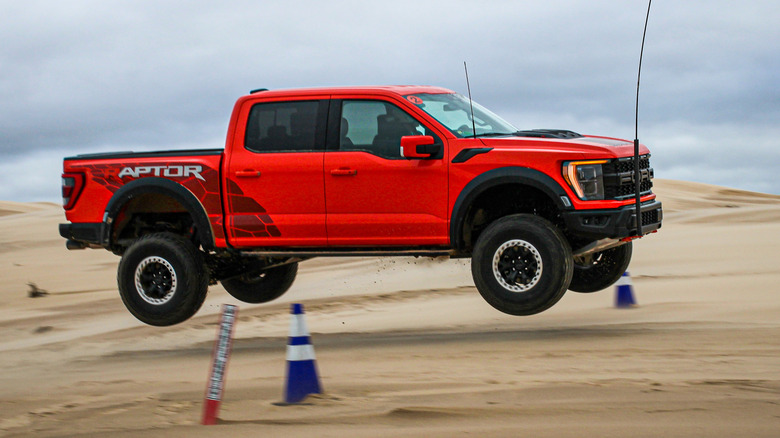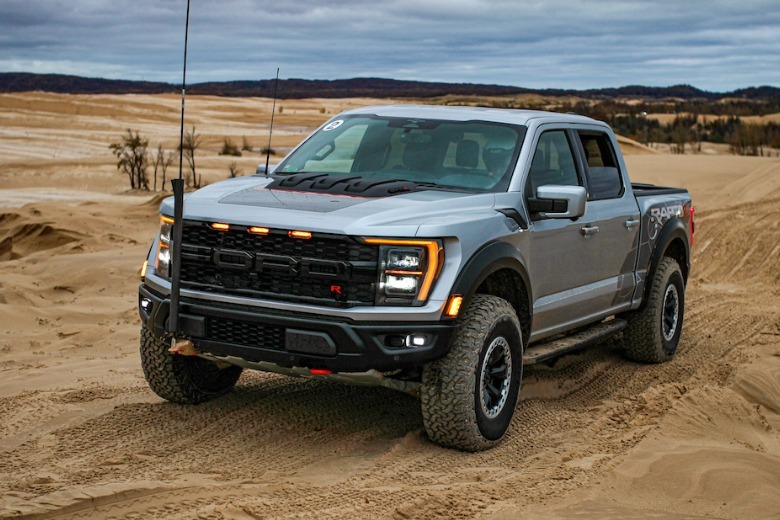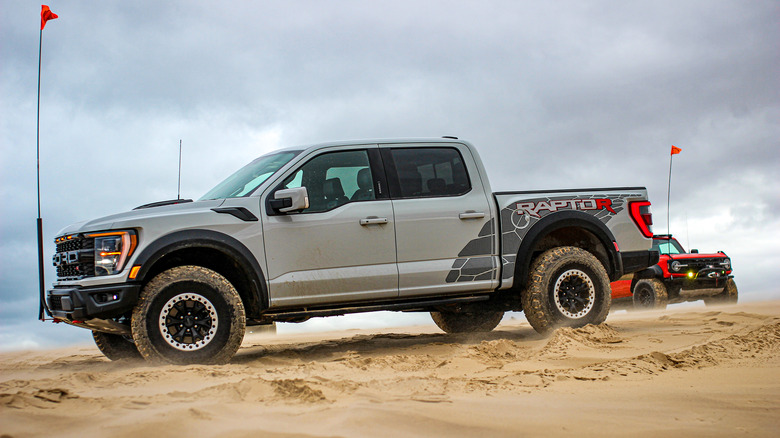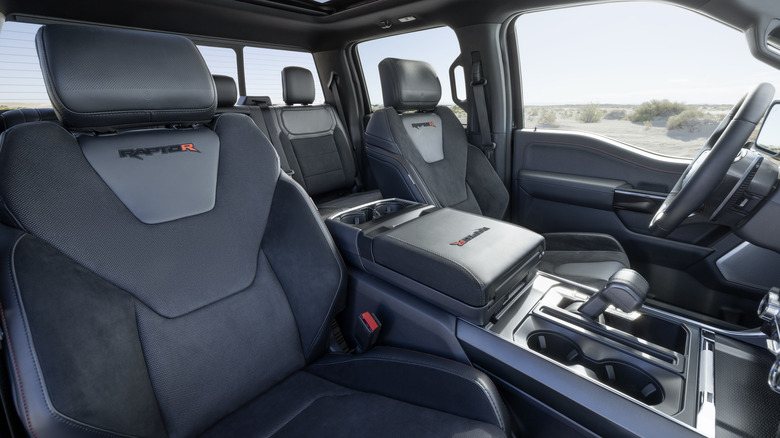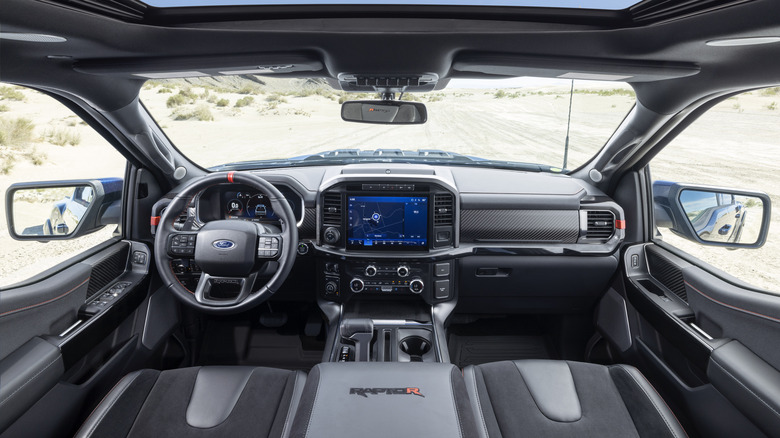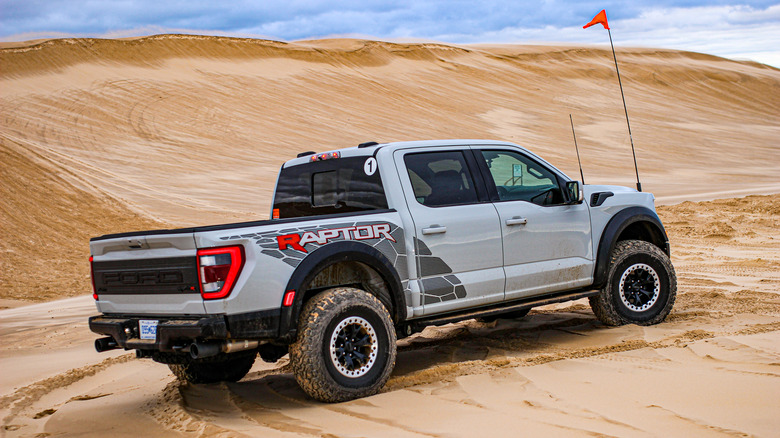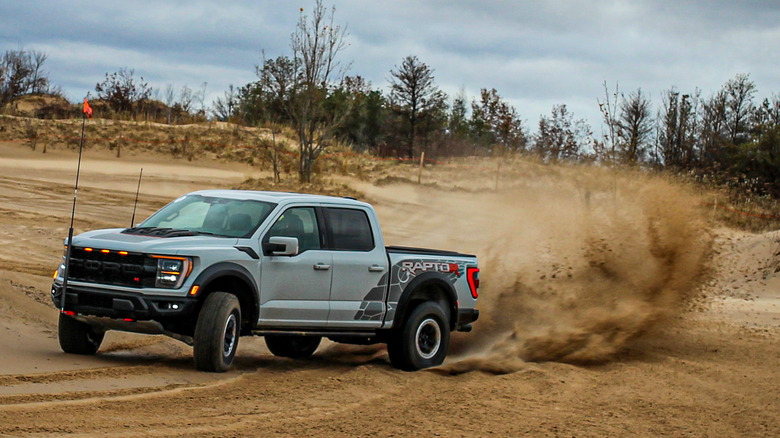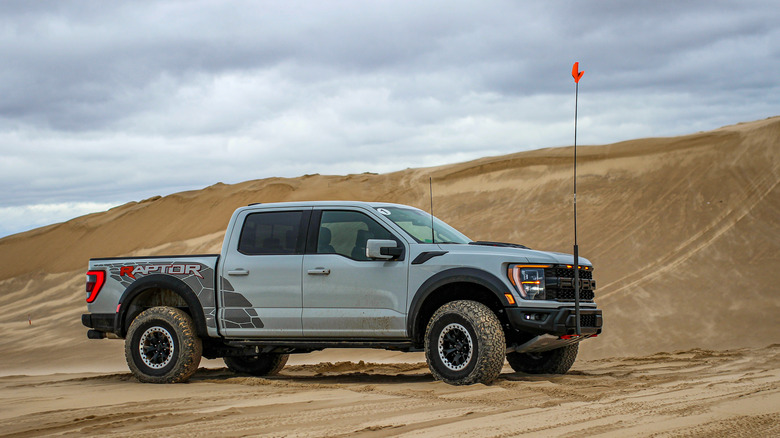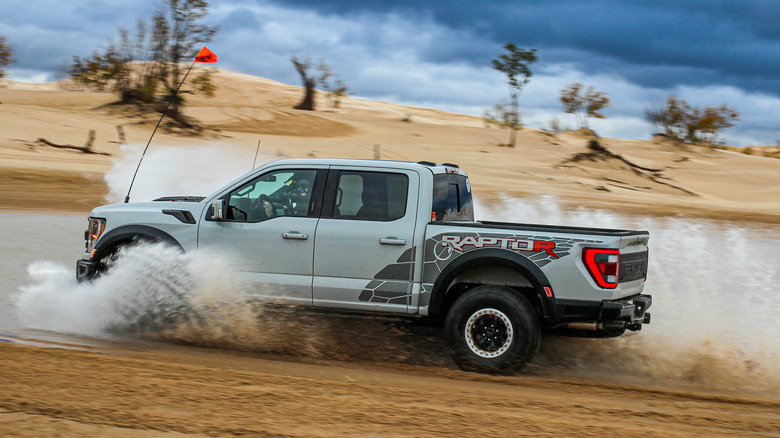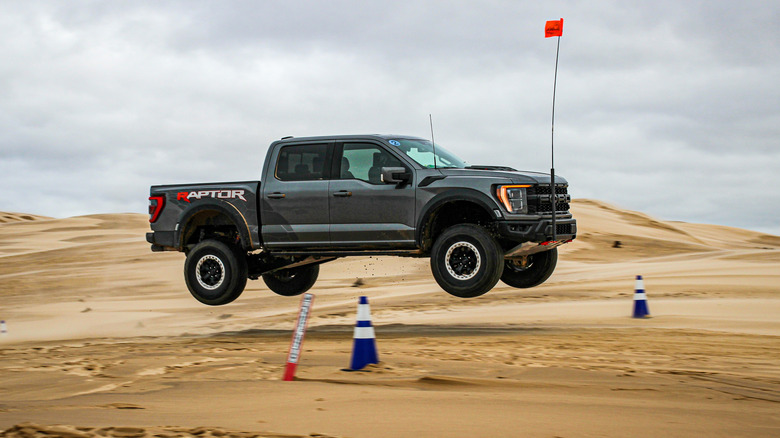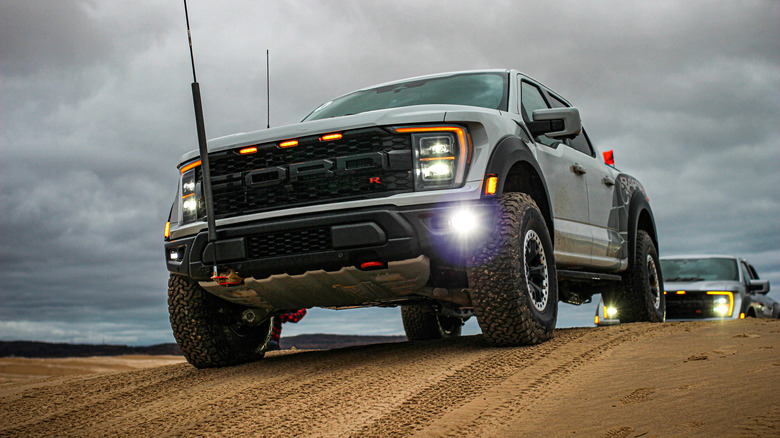2023 Ford F-150 Raptor R First Drive: Rip And Tear
In 2010, the Ford F-150 Raptor first bashed its way onto the scene Kool-Aid Man style, and just as our juicy friend did to many a brick wall, it instantly made a huge impression. It was the sport version of the already beefy and ultra-capable workhorse F-150 pickup, kitted with an off-road racing suspension and optioning the Super Duty's brawny 6.2-liter V8 to give the Raptor 411 horses of full-send power. It didn't take long at all for the Raptor to be considered "the crazy one" of the already horsepower-mad Ford family. Its moniker quickly became shorthand for an off-road ready vehicle built to the extreme, and "Raptor" versions of the Ranger and Bronco were inevitably to follow.
When the time came to update the F-150 Raptor for its second generation, Ford saw fit to tone down a bit of the whimsy, replacing the V8 with a more sensible turbocharged V6 to highlight its EcoBoost technology. Though lighter and – more importantly – more powerful, this touch of pragmatism took a bit of the bloom off of the wild flower the Raptor was meant to be for some fans. Indeed, it conceded enough ground for Ram to let its 1500 TRX loose onto the scene, where it became the apex predator of the sport truck domain.
Ford, understandably, wasn't going to let that slide, and now, in its third generation, the Raptor's V8 heart beats once again, and does so with a vengeance within the 2023 F-150 Raptor R. Though its capability was never in question, after spending a day with the fortified pick-up in its natural habitat, it's clear that the madness is indeed back.
Heart of a stallion
The Ford F-150 Raptor R is the ultimate expression of the Raptor brand. Its key feature is a supercharged 5.2-liter V8 that produces 700 horsepower and 640 pound-feet of torque. Ford fans will recognize this as the monster power plant that sits in the front of the current Mustang Shelby GT500. Oil cooler, filter, and pan upgrades make it more off-road ready, and upgrades to the air intake give it 66% more volume to keep engine temperatures down. That and a myriad of calibrations make the engine more suitable for truck use, delivering more low-to-mid-range torque.
Power is sent through a 10-speed automatic gearbox from which it is then distributed through a 2-speed torque-on-demand 4x4 system with an electronic locking rear differential. All of this fun stuff rides on what is arguably the Raptor's true showcase, an incredibly capable suspension designed to take much more of a beating than your everyday F-150, which is saying something. The five-link suspension in the rear sports extra long trailing arms, a panhard rod, and coil springs. The front rocks an independent double-wishbone setup, while the whole thing is supported by high-output, gas-pressurized Fox racing shock absorbers. These are electronically controlled and have the ability to continuously vary the compression damping, depending on the terrain. Apart from a 5% spring rate up front, it's the same suspension setup as the now-base Raptor model.
Raptor enclosure
This is essentially the case throughout the rest of the Truck. Beyond the engine and small suspension adjustments, it's nearly identical to the EcoBoost-powered model, though the Raptor R does get some notable highlights to distinguish itself, "R" badges highlighted in Code Orange, a unique graphics package for the side, and a beefier hood that's about an inch taller than usual all help it stand out. Beyond that, it's still the Raptor-ized version of the F-150 SuperCrew cabin, with the same dimensions as the current Raptor sporting the 37-inch sport tire upgrade instead of the 35-inch standard set. With the larger wheels, the Raptor R has a 33.1 degree approach angle, a 24.9 degree departure angle, and 24.4 degree breakover angle.
Inside, the roomy SuperCrew cabin remains the versatile work/living space the F-150 has been known to provide. In the Raptor, leather and Alcantara suede Recaro seats are equipped to hug occupants as tightly as possible when bouncing across uneven ground. Behind the beefy steering wheel is a digital instrument cluster containing a wealth of gauges and system information that can be configured to suit the driver based on the situation. Beside it is a 12-inch touch screen powered by Ford's SYNC 4 operating system, which is also Apple CarPay and Android Auto compatible.
Clever grrrl
Ford's suite of driver assists and alerts are present, as well as an adaptive cruise control that not only slows when detecting forward traffic, but when there's a change in speed limit, which will be invaluable in the Raptor R. Bringing more brain to the Ford's brawn is the collection of drive modes on hand to make anyone behind the wheel a master at traversal.
Mechanically, the Raptor has high-and-low range 4x4 functionality at its disposal, along with 4x2 driving for normal or sport settings. These work with the terrain management system that adjust the car's behavior to tackle whatever is thrown at it. Mud, sand, rocks or grass, the Raptor R can dial in the proper configurations to deal with them best, be it throttle input, traction control intervention, gearbox behavior and so on. A special Baja mode brings these systems together specifically for the Raptor, which will certainly come into play later.
Pack leader
You might be surprised, but simply taking a vehicle for an off-road adventure doesn't require much in the way of horsepower. Every bit helps, for sure, but sheer brawn doesn't matter as much as dexterity and torque delivery. With this in mind, getting to the meat of what the Raptor R was all about would require more than a crawl through some dense wilderness. It necessitated a testing ground that was a suitable challenge for the madness contained within, and this made Michigan's Silver Lake State park the ideal location to let the Raptor run wild.
The park's main attribute is its vast expanse of sand dunes nestled between the titular Silver Lake and Lake Michigan. A large swathe of the area is dedicated off-roading vehicles, which are typically made up of UTVs that are purpose-built for such environments. Light and quick, they usually dart around the larger utility vehicles brought there to test their technical capabilities on the shifting sands, but on the day of our visit, they had to make way for the raucous Raptor R.
Baja blast
Roaring onto the scene, the Raptor R felt right at home, particularly set to its "Baja" drive mode. A nod to the grueling Baja 1000 off-road race that feature Ford-powered trophy trucks, the mode is meant to be a sort of blend of the Raptor's Sport and off-road settings, which are usually manifestations of two different personalities. Sport tends to be a showcase of the Raptor's on-road prowess while the various off-road settings demonstrate the Ford's versatility on different terrains, often requiring a slow, methodical touch.
Baja offers up the full scope of the truck's all-terrain capabilities along with the increased throttle response and sharp gearbox behavior and long, long holds onto gears. In essence, it's the Raptor R's full potential untethered.
Imminent dune
All of it would be welcome in the shadow of the massive dunes that towered overhead. Tapping into what the engine had to give made it a breeze to give the Raptor enough speed to run up the dune's steep sides and onto the narrow plateaus that awaited at the top. Indeed, it was more of an effort to maintain just the right momentum to avoid careening over to the other side. What helped was the on-by-default front camera that displayed the area beneath the truck's chin, allowing me to quickly peek over the dune's edge to gauge the drop or spot the location of another vehicle in the area.
Hitting dune after dune felt like dropping into a half-pipe with a nearly 6,000-pound metal box on wheels: thrilling, exciting and just a bit silly. It was a sensation that persisted on the flatter areas at the base of the dunes, as was impossible to deny the overwhelming sensation of mischievousness the Raptor R inspires. With a sandy open expanse and 700 horses to play with, well... horseplay was inevitable.
Glutton for punishment
With damp sand underfoot, the Raptor R had no problem darting forward as it full-throat screamed out of the back of its open-damper exhaust. With a flick of the wheel and a heavy foot on the throttle, the truck ripped sideways through long, sandy slides only relenting when I did. Baja mode defaults to four-wheel drive, which limited the rear's sliding but made the runs faster and easier to control, though a simple button press to 2WD turned a hooning session into a full-on riot.
Back in four-wheel drive and tackling some smaller dunes, the Raptor R was a glutton for punishment, as we crested over the side of dunes – truck surfing, if you will – and then came crashing down, running over ruts and dusty moguls with abandon onto the next play area. Silver Lake's ever shifting terrain presented the Raptor with a myriad of challenges that it tackled with little effort. In pillowy batches of sand, the vehicle's throttle management, along with its ample grunt, allowed it to wade through without the overwhelming concern of being beached. In other areas, the Raptor shuddered while finding grip as we climbed over hills and through trees. During which, the prevailing thought was how much work the car was doing and how, if I were in a lesser vehicle, I'd be putting myself in a multitude of bad positions.
There was also the fact that I was, frankly, indelicate with the Raptor R. When a situation called for a light touch, I brought the hammer down. If there was a smoother path, I took the rough one. As they say in off-roading "as slow as possible, as fast as necessary," but the Raptor R encourages the opposite like your most troublemaking friend. Y'know, the fun one. Throughout it all, the Ford took its lumps and just kept on chugging along. You can break any truck if you try hard enough, but everything I threw at the Raptor R wasn't enough to slow it down.
Hold on to your butts
This holds true when given the opportunity to demonstrate part of the Raptor R's trophy truck heritage. All trucks are small trucks when in an area like Silver Lake's dunes. The crash-helmeted devil on my shoulder would constantly point at the natural structures that dwarfed the truck and mutter into my ear, "you could jump that."
Knowingly, the Ford crew in charge of our field trip scouted out and arranged an area for us to get the F-150's wheels off the ground without causing irreparable damage to ourselves or our four-wheeled companion. With Baja mode still engaged and no further settings to adjust, it was just a matter of having enough room to run before hitting the natural ramp that was presented before us. Our professional scouts instructed that we should maintain a 45 mph speed to give us a satisfying demonstration of hopping all four of the Raptor's wheels up before a smooth touchdown.
As you can imagine, it's in everyone's best interest to listen to such instructions, but a day's worth of comfortably bashing the Raptor R, coupled with that little voice in my ear and a very enthusiastic V8, it was a little difficult to keep that 45 mph promise. "I don't want to hit it too slow, that would be dangerous, too, right?" said the voice, as the speedo churlishly climbed over 50 mph at the jump point. I don't remember what speed I hit exactly at the jump, nor much of anything in the first couple of seconds, as the sensation of launching in F-150 violently into the air was enough to induce a rush of survival adrenaline to the brain. The fog cleared up quick enough for me to brace for the landing, and once we touched down, the Fox sport shock absorbers performed their job admirably. The truck came down hard, but didn't slam on the decline. From the outside, it probably looked like a gentle hop, but from inside it feels like plummeting off a cliff. I couldn't wait to try it again.
Nuts truck
The funny thing about the Raptor R is that the big showcase centerpiece isn't the most impressive feature of the sport truck. Sure, it brings a dab of extra towing prowess and sporty speed, but that extra horsepower doesn't steal the show from the Raptor's inherent versatility. It merely complements the best parts of the truck with a hefty amount of lunacy, which is very much the charm of such a truck. The V8 is an element of the power fantasy trucks like the Raptor and Ram TRX attempt to fulfill: the ability to be biggest, baddest dog on the block that's able to brute force through any situation.
From behind the wheel of both, it's a very compelling sensation. That satisfaction comes with a hefty price tag, either way you slice it, with the TRX starting at around $80,490 while the Raptor R comes in at a cool $109,145. That's about $26,000 more than the already capable, yet slightly more reasonable EcoBoost-powered Raptor. If that's worth the reassurance that you hold the reins of a 700-hp in a street-legal monster truck, fine, go nuts. Truck nuts.
